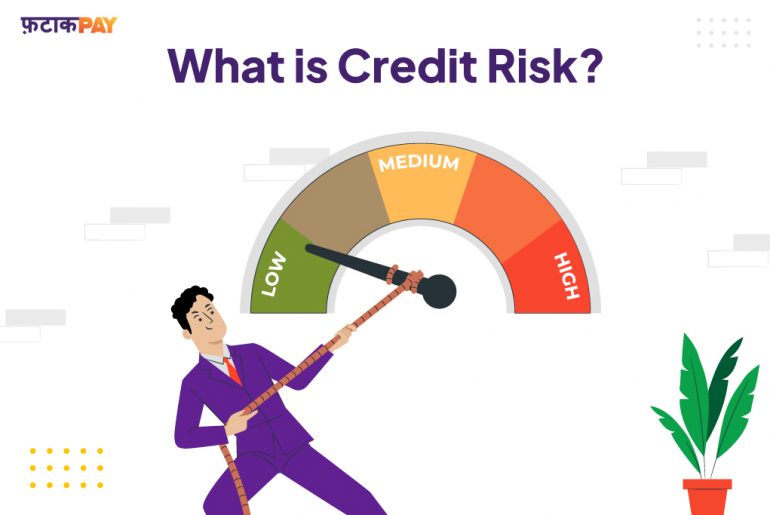Introduction:
Credit is a promise to pay for something of value later, typically with interest charged by the lender. Credit Risk is created when one party (borrower) receives resources from another party (lender) without immediate payment.
Based on the borrower’s or the business’s capacity to meet future obligations, loans may be granted (of principal and interest). Lenders go to tremendous lengths to comprehend a borrower’s financial situation and to determine the likelihood that the borrower would eventually cause a default event.
Usage of Credit by companies and Individuals:
Companies may use Credit to help grow and operate their business. It may be short-term or long-term.
Individuals may seek Credit for things like Credit Cards or longer-term loans such as car loans or home loans.
Some insights about Credit Risk:
Some people refer to counterparty risk as a form of Credit Risk, other people only refer to default risk as Credit Risk.
In case of Default Risk, The 2 components of Credit Risk are:
- The probability of default happening
- Amount of the loss due to the default
We can multiply the above 2 parameters to get the Expected Loss. The Expected Loss can be used to compare one loan to another loan and so on. Some loans have a higher probability but a small loss, whilst others may have a low probability but a huge amount of loss.
If someone has a high probability of defaulting (seen specifically in unsecured lending), the borrower is likely to be charged a higher interest. Credit Risk plays a huge role because if it is not managed properly, it can bring down financial intermediaries.
Liquidity Trap and Amount of loss:
Some people assume that credit risk can be countered by stopping lending, but by stopping lending money, you create a liquidity trap, so people can’t do business and hence we had the recession that came from the Credit Crisis.
Amount of loss is easy to calculate, but that is not the case with probability of default. It is difficult to model the true probability of an individual defaulting. The best we can do is do some sort of estimate for the category that the person falls under.
Late Payment and Credit Spread
Late Payment falls under Credit Risk and Liquidity Risk. A change in Credit Spread can be seen as Market Risk and Credit Risk. A change in Credit Spread could mean a bond going from a AAA rating to a AA rating. The reduction in your credit rating is known as Credit Spread. This can change the value of a bond.
Systemic Risk as Credit Risk
Contagion or Systemic Risk is also sometimes classified as Credit Risk.Systemic risk says that if one part of a machine breaks down, the whole system comes to a halt.
Let’s imagine a supply chain. Person A lends money to Person B. Person B then lends money to Person C. If Person C fails to repay Person B, Person C defaults.This thing causes Person B to default and then this same phenomena causes Person A to have problems.
Using collateral as a way to mitigate credit risk does not always work. Let’s say that a person goes to the bank and takes a loan of Rs.50 Lacs. The bank tells him, if he doesn’t pay the loan amount, the bank authorities will possess his house/property. However in the event that the bank does possess the house, they may be unable to recover the complete amount of Rs.50 Lacs as they may face difficulty in selling it in the market. This is because Real Estate is difficult to sell; it is not as liquid as stocks. Chances are that the bank authorities would be only able to sell the house for Rs.30 Lacs, which would result in a loss to the bank.
The role of information in managing credit risk:
Let’s illustrate the role of information in Credit Risk: Let’s say we have person A and person B. Person A and B both want a loan. If only one person could be chosen, how do we decide who should be given a loan? We can’t decide on their names alone. We need more information.
Person A has a salary of Rs.30,000 per month. Person B has a salary of Rs.15,000 per month. Based on this information, it is tempting to say that Person A should be granted the loan since he has a higher salary. However, let’s introduce another variable.
However, Person A has expenses of Rs.23,000 whereas Person B has expenses of only Rs.3000. Person B has more savings. As per this information, Person B is a better candidate for a loan. However, let’s introduce another variable.
Person B’s job is ending at the end of the month. So the disposable income that person B has is not sustainable. As you see, after each piece of information we get, it changes our opinion of the person.
However, one thing should be noted. Information costs money and time. For example, if Person A has to fill out an entire form with a lot of details for Bank A, whereas Bank B asks only a couple of questions, Person A would more likely go to Bank B due to convenience and less paperwork.
With Information, one has to look at the time,effort, marketability, and the cost of getting that extra information.
Managing Credit Risk:
Credit Risk management is a multi-step process. It can be divided into two major categories. They are:
- Measurement
- Mitigation
Measuring Credit Risk:
Lenders evaluate Credit Risk using their own unique risk evaluation systems, which vary depending on the company or region and are based on whether the debtor is a consumer or a commercial borrower.
In order to make a personal loan, creditors will need to know the borrower’s financial condition, including their income (in relation to all of their responsibilities), other assets, and liabilities. They will also want to know how their Credit history looks. Personal guarantees and collateral are frequently used in personal financing.
On the contrary, commercial lending is considerably more complicated, and many company clients borrow bigger sums of money than do private customers. A number of qualitative and quantitative methodologies are needed to rate the risk of a commercial borrower.
These are some categories of qualitative risk assessment:
- Knowing what’s happening in the corporate world and the larger economy
- Examining the borrower’s industry of operation
- Assessing the company’s strengths and weaknesses in the market as well as its growth plans
- Examining and comprehending the ownership and management (if the business is privately owned). The examination will take management’s reputation and the owner’s personal Credit Scores into account.
- Financial analysis makes up the quantitative portion of the Credit Risk assessment. To determine the borrower’s overall financial health, lenders consider a number of performance and financial ratios.
A borrower’s credit assessment will result in a score based on the lender’s own analysis methods, models, and underwriting criteria more generally.
There are numerous names that can be given to the Credit Score. For instance, Credit Ratings or Debt Ratings are used to describe scores for public debt instruments (such as AAA, BB+, etc.); risk ratings may be used to describe scores for individual debtors (or something similar).
The likelihood that the borrower will cause a default event is indicated by the score itself. The likelihood of a borrower defaulting decreases with increase in Credit Score and rating; it increases with lower scores and ratings.
Mitigating Credit Risk:
If Credit Risk is not properly managed, lenders may experience loan losses, which have a negative impact on the financial services industry’s profitability. Among the techniques used by lenders to reduce Credit Risk (and loan loss) are, but are not limited to:
Credit structure
Credit structuring approaches enable some reduction of Credit Risk.
The amortisation duration, the utilisation of (and the quality of) collateral security, LTVs (loan-to-value), and loan covenants are a few examples of credit structure components.
For instance, a riskier borrower might have to agree to a shorter amortisation time than usual. It’s possible that a borrower will need to submit more frequent (or thorough) financial reporting.
It is crucial to comprehend any attainable collateral security and structure Credit appropriately.
Sensitivity analysis:
Sensitivity analysis is the process by which a lender modifies a few elements of the proposed Credit Structure to determine how the borrower’s Credit Risk would vary if the speculative circumstances materialised.
Consider a scenario in which a lender wants to offer loans at a 5% interest rate; they might want to know how the borrower’s Credit Metrics stand up at 7% or 8%. (in the event that rates ever increase materially). It is referred to as a “qualifying rate”.
A lender might be considering providing a borrower with a 10-year term loan, but they might first want to evaluate how the Credit Metrics would alter if the loan had a 6- or 7-year amortisation (in the event that conditions changed and the lender wanted to accelerate the repayment of loan).
The 5 Cs of Credit:
The 5 Cs of Credit are a paradigm that is frequently used to help understand, measure, and mitigate Credit Risk. There are 5 Cs:
Character
If it’s a personal loan, who is the borrower and does he or she have a good Credit history?
In relation to commercial creditors, Character refers to the reputation and dependability of a firm’s management; if a company is a private corporation, character also includes ownership.
Capacity
Capacity refers to a borrower’s capacity to acquire and repay debt. Different debt service and coverage ratios are used to assess a borrower’s capacity for both retail and commercial borrowers.
Understanding the borrower’s competitive edge is important for commercial lenders since it will affect the borrower’s ability to produce cash flow in the future.
Capital
The “wealth” or overall financial health of a borrower is frequently described as their capital. Lenders will try to figure out how much debt and how much equity sustains the borrower’s asset base. It’s crucial to know whether a borrower can obtain alternative funding from other sources.
Is there a linked business with available funds (for a business borrower)? Can a parent or other relative guarantee a personal loan for a borrower who may not have a stellar credit history?
Collateral
Collateral security plays a crucial role in how loans are set up to reduce Credit Risk.
Understanding the value of the assets, their location, the ease of transferring the title, and the right LTVs is crucial (among other things).
Conditions
Conditions include the goal of the Credit, extrinsic events, and other elements of the outside world that could present risks or opportunities for a borrower.
These can be political, macroeconomic, or related to the current phase of the economic cycle. For business borrowers, Industry-specific difficulties and societal or technological advancements that could affect competitive advantage.
Additional links:
We hope this was an informative and pleasant read. You can check out some our previous blogs and LinkedIn Articles:
https://fatakpay.com/blog/the-smart-way-to-use-credit-cards/
https://www.linkedin.com/pulse/what-assurance-fatakpay/?trackingId=yjfSWmUE8J2i%2FiNKd22zfg%3D%3D
About FatakPay:
FatakPay provides virtual credit facilities for all. It’s available on your phone and caters to your everyday needs in both online and offline format. Payments are done seamlessly through UPI/QR codes. The solution provides an almost zero cost, free, quick, transparent and a secure way to transact in multilingual format with a Scan Now Pay Later facility and easy repayment options.
Link to FatakPay App: https://play.google.com/store/apps/details?id=com.fatakpay
Link to the Website: https://fatakpay.com/







